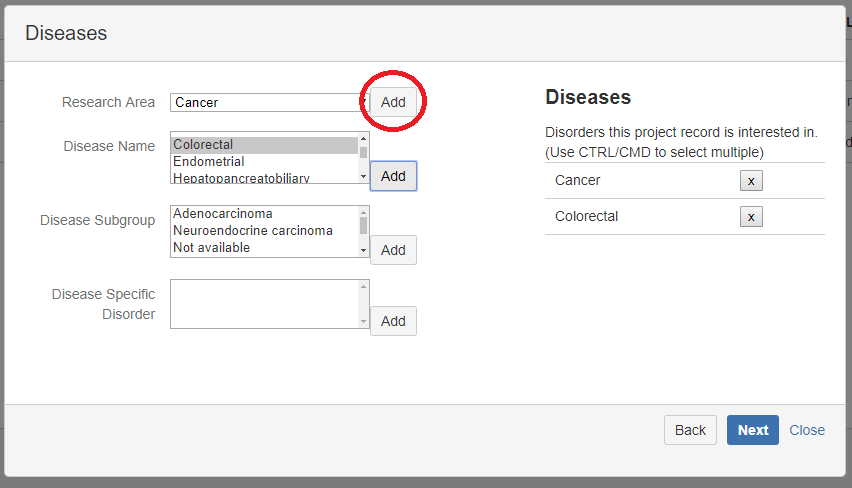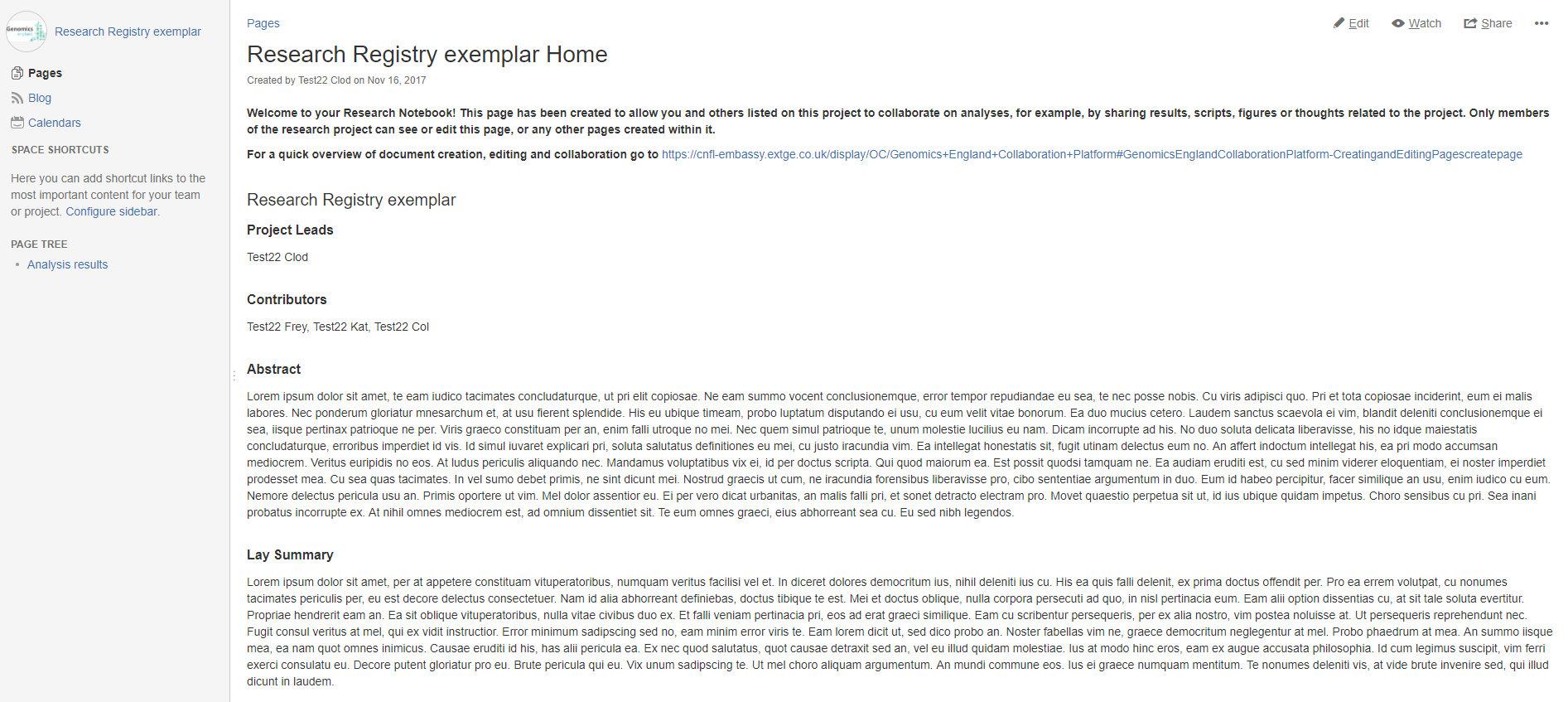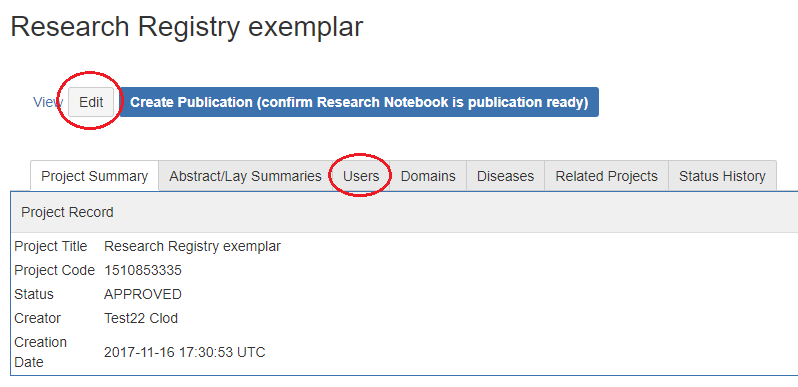Contents
| Table of Contents | ||
|---|---|---|
|
Where is the Research Registry located and what functionality does it provide?
The Research Registry is based on the internal Confluence space within the Research Environment to enable GeCIP members to register their research projects. The Research Registry will provide a mechanism for GeCIP members to search through the current research projects and to request to join particular research projects.
Why do I need to register a project?
The Research Registry has been designed with the following aims in mind:
- To provide a mechanism to enact the Publication Moratorium rules: Disease-facing domains have a protected time period for analysis and publication on participant data pertaining to their domain in recognition of the efforts of the domain members who have assisted in recruiting participants to the project.
- To provide a mechanism to assess adherence to the Genomics England Publication Policy: Authorship and co-authorship of any publication or output should be defined in accordance with the guidelines issued by the International Committee of Medical Journal Editors (ICMJE) and outlined in the Genomics England Publication Policy. Note that a registered research project should comprise research aimed to result in a publication, such as a journal article, or a piece of work within a student thesis. Hence, multiple projects can be registered within a single domain. For a full definition of a project see here.
- To assess that the proposed research adheres to acceptable uses of data for which the Access Review Committee has granted data access approval: Genomics England will be able to review whether a proposed research project falls within the scope of the detailed research plan submitted by the domain and as such that no additional data access requests need to be considered.
- To promote collaboration and to reduce duplication of effort within the Research Environment: Registering a project will allow researchers within your domain and throughout all of GeCIP to be aware of the work that is carried out within the Research Environment.
- To allow export of analysis results: The Research Registry provides a page for collaborative development of a manuscript within the Research Environment. Use of this page to prepare a manuscript is not compulsory; manuscripts can be written outside the Research Environment. However, the Airlock Review Team will be reviewing requests for export of analysis results and manuscripts against the Research Registry information, so your project still needs to be registered. Manuscripts and analysis results will be allowed to leave the Research Environment only if they adhere to the criteria outlined above (ie if they abide by the Publication Policy, relevant Acceptable Uses of Data and the Publication Moratorium).
| Anchor | ||||
|---|---|---|---|---|
|
A research project is considered to be any set of analyses or investigations that would ordinarily be the subject of a single research article, or piece of work within a student thesis. In some cases this may change during the research period; for example, a project may grow to encompass more than one planned publication. For this reason, you can add more than one publication to a record in the Research Registry.
The projects submitted to the Research Registry will be reviewed by Genomics England to ensure that they are within the bounds of valid Access Review Committee approval from the research lead’s domain. The Research Registry also provides Genomics England with an overview of the research activity being undertaken in the Research Environment; as such, any files moved out through the Airlock must be associated with activities covered by a registered and approved research project.
Who can register a research project?
A project can be registered by anyone who wishes to lead on a study that is aimed to result in one or more publications and would otherwise be considered to be the lead author on a publication, or a student/supervisor of a student project.
...
Please note, you can use genomes protected under another domain's moratorium as controls or to investigate a disease unrelated to the domain they fall within.
Who can join a project?
When a project lead registers a project, they provide a summary of the work they plan to carry out. This abstract is visible to all GeCIP members, regardless of their involvement in a given project. A list of all current and completed research projects is available within the Research Registry and can be reviewed by all GeCIP members accessing the Research Environment. Project status is given for each entry, indicating the progress of the project through the Research Environment.
...
- A GeCIP member is interested in joining a project within their domain. While each project lead is encouraged to positively consider applications to join a research project, the decision on whether to accept or reject an application is entirely theirs.
- A GeCIP member is interested in joining a project outside their domain. As above, the project lead may decide whether to accept the applicant. If accepted, the applicant is collaborating with the domain in question and is not restricted by the moratorium period.
How do I review the status of a project?
To view the Research Registry, you need to click ‘GeCIP Projects’ at the top of a Confluence page within the Research Environment:
...
- New – just been created
- Under review – being reviewed by Genomics England, not yet approved
- Approved – project has been approved by Genomics England and can begin work
- Publication in draft – research team has created a publication and are writing up their project
- Publication under review – project has been completed and is waiting export via ‘Airlock’
- Publication in submission – project has been exported and submitted to a journal
- Published – project has been published in a journal.
Using the Research Registry at a glance:
The flowchart below outlines a series of steps necessary to register a project and use the Project Registry for collaboration purposes. For detail on specific items, please go to the subheadings below.
How to register your project
You need to complete two steps to register your project. First, you need to create a new space within the Research Registry and then you need to submit it for approval.
Step one: Create new Research Registry space
To create a research project within the registry, you must first log in to the Research Environment and open up Confluence. Go to ‘Spaces’ in the left-hand corner of the menu bar along the top of the page and then click ‘Create space’ in the drop-down menu.
...
Research projects should be registered by the research lead who will need the following information in order to complete their record:
Project owners
- Project title
- Project lead
- Co-researchers
...
Note, external collaborators will not be able to view and interact with the project space in Confluence as they will not have the necessary credentials to log into the Research Environment.
Disease area
- Disease group
- Disease subgroup (if applicable)
- Specific disorder (if applicable)
...
If you add diseases by mistake, click the x beside the disease name and it will be removed from the list.
Funding
If you are applying for funding or have received funding for your project, you should state this on this page. This will be used to determine who owns the intellectual property for your project.
Abstract and lay summary
You must provide an abstract and lay summary of your project. These will be visible to anyone looking at the Research Registry. The lay summary may be used to describe your project on the Genomics England public website, if permission is granted by the project lead, and should be understandable by patients and the general public.
GeCIP
You will need to select the GeCIP domain(s) that the project pertains to. You should be a member of this domain:
...
If your project is part of more than one domain, you can add addition domains in the ‘Other GeCIP Domain(s)’ section. You can select multiple domains by holding CTRL/CMD and clicking the domain name.
Related projects
If there are other projects within the Research Registry that are related to yours, you can add them here.
When you click ‘Create’ after inputting these details, your project will be added to the Research Registry. However, it has not yet been submitted to Genomics England for approval and you should not start work.
Step two: Submit for approval
To submit your project, you need to go back to the list of all projects in the Research Registry Directory and find your project in the list. The status will be listed as ‘NEW’. Click on the ‘i' icon on the right-hand side of your record and it will bring up a summary page of your project. Check this is correct and then click ‘Submit Project Record for Approval’.
...
Your research project will have its own space within confluence where all members of the project can create and edit pages. You can use this space for writing updates on your project, problem solving, writing up your methods/results, etc. The home page is automatically created when you submit your project and you can customise this in any way you like. Only those who are listed as co-researchers can edit the pages within your project’s space, but all GeCIP members can view them.
How to join an existing project
All projects submitted to the Research Registry are visible in the project directory. On the main page you can see the date each project was created, the title, lead researcher and the status. If you click the little ‘i' icon on the right-hand side, you will be taken to a more detailed summary of the project, including the abstract, diseases covered and the GeCIP domains involved.
...
You cannot request to join a research project once it reaches ‘PUBLICATION IN DRAFT’ status as at this point it is expected that all research on the project is complete and the project team are working on writing up their results for publication, so you would not meet the ICMJE authorship criteria.
How to approve someone to join your research project
GeCIP members can view all research projects that have been registered and can request to join those they are interested in and feel they can contribute to. When someone requests to join a project, the research lead will receive a notification; their application will include their name, relevant skills and reasons for wanting to join. We encourage collaboration and ask that you positively consider applications to join a research project.
...
Click ‘edit’, navigate to the Users tab and then add them as a co-researcher.
How to create your Publication Notebook
When you have completed your research project and are ready to begin working on a publication to submit to a journal, you can create a publication notebook within your research record. First, you will need to go to the summary page for your project by clicking on the ‘i’ beside your project in the Projects Directory. Then click ‘Create Publication’.
...



